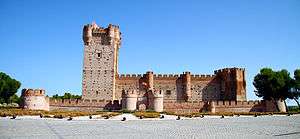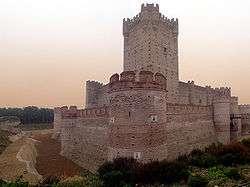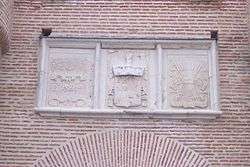Castle of La Mota
| Castle of La Mota | |
|---|---|
| Castillo de La Mota | |
|
| |
 Castillo de La Mota | |
| Type | Castle |
| Site information | |
| Owner | Junta of Castile and León |
| Open to the public | Yes |
| Condition |
Spanish Property of Cultural Interest Castle of La Mota 3 June 1931 RI-51-0000980 |
| Site history | |
| Built | 14th century-15th century |
| Materials | Bricks |
The Castle of La Mota or Castillo de La Mota is a medieval fortress, located in the town of Medina del Campo, province of Valladolid, Spain. It is so named because of its location on an elevated hill, a mota (in Spanish), from where it dominates the town and surrounding land. The adjacent town came to be surrounded by an expanding series of walls in subsequent years, of which little remains.
It has been protected by the state since 1904, first as a national monument and more recently as a site of cultural interest, or Bien de Interés Cultural.[1]
It is located on the hill of La Mota [2] Los castillos a través de la historia, p.146º/refª, at 1,029 meters above sea level, in the city of Alcalá la Real, in the province of Jaén (autonomous community of Andalusia, Spain), dating from the Nasrid period (13th and 14th centuries), although with some previous elements.
Overview
The castle's main feature is the large outer barbican. The interior castle has a trapezoidal plan, with 4 towers and a square yard. It has a large square keep tower, and an inner curtain wall that was used for archers.
The castle was originally accessed through a drawbridge. It is made from local red brick, utlilizing stone only for some details.
History
_(4).jpg)

_(19).jpg)

Initial fortification of the village, repopulated after Moorish depredations, led to the creation of a fortress on the site, starting in 1080. The village soon grew alongside. In 1354, Henry of Trastamara is known to have taken the fortress by force. In 1390 King John I of Castile granted the town to his son, the infante Ferdinand of Antequera, future king of Aragon. After the latter's death in 1416, his son, John II of Aragon, in 1433 taxed local residents to help the construction at the Mota. During the following century, the castle and town changed hands between the rival kings of Castile and Aragon, with the castle and town being sometimes held by opposing sides. In 1439, for example, the prince of Aragon locked the town gates, thereby imprisoning the Castilian king within the castle walls. In 1441, the Castilian king was able to obtain the surrender of some 250 soldiers of Aragon within the castle.
After the First Battle of Olmedo in 1445, the castle came once and for all into hands of the Castilian monarchy. In 1460, King Henry IV of Castile built the central tower. In 1464, Henry gave the castle to the Archbishop of Toledo, Alonso Carrillo, who soon betrayed the king, and backed the rival claimant Afonso V of Portugal. After taking the castle by force, it fell by 1467 into the hands of supporters of King Afonso, while the village supported Henry.
Subsequently, the castle was disputed between the princess claimant, Isabella of Castile and her cousin of dubious paternity, the princess Juana la Beltraneja.
After a succession of owners, in 1475, the crown of Castile reclaimed the castle, and built an artillery bastion, upon whose entrance are the heraldic symbols of the Catholic Monarchs, Ferdinand and Isabella.

The castle became a prominent prison, and variously housed Hernando Pizarro,[3]:143 Rodrigo Calderón, Duke Fernando de Calabria, and Cesare Borgia, among others. Of these men, the last is known for having escaped from the nearly 40 meter high tower by climbing down a rope.
Description
The Castle of Alcalá la Real, is arranged, as was usual in the Andalusian fortress-cities, in three enclosures:
The outer enclosure, formed by the defenses of the medina, closed by a wide fence that included several suburbs, among them the one called "Arrabal Viejo", better conserved. Its original layout, corresponds to the eleventh and twelfth centuries and, currently, very little remains of the wall remain. This wall was initially built with mud and mortar, although it seems that it was remodeled in the thirteenth and fourteenth centuries, covering it with masonry[4] walls. Some authors consider that there was another fence, even more external, that was possibly an albacara of earth and wood[5].
The citadel, or interior enclosure, that occupies the whole of the plateau located at the top of the hill of La Mota, and that was the site of the original city, surrounded by a wall. At the time, it had several doors that gave access to the interior: The "Puerta de Santiago", was located in the northwest, and communicated directly with the outside of the medina; the one of "San Bartolomé" was in the extreme southwest, and also acceded directly to the outside. However, the main access climbed the so-called "Cuesta de la Mota" and was done through seven doors, of which, at present, only three remain standing. By order we access a first door (disappeared and no known name) and then the door "De Las Lanzas", protected by an albarrana tower. Then the monumental door in a corner, called "Door of the Image", with double mixed arcade of half a point (the first of them) and a horseshoe (the second). It is very similar to the Puerta de la Justicia of the Alhambra[6]. After this one, there were the disappeared "Puerta del Pendón" and "De Aguilera". And, afterwards, the "Door of the Weight of the Flour" had to cross, which was the one that communicated the citadel[7] with the high square, and where the entrance fees to the city [8] were paid. A last access passed through the call "Cañuto" or "Gaván", a covered passage that acceded to the walled enclosure, and that was destroyed by an earthquake in century XVI.
Finally, the fortress, the last defensive enclosure, was located in the highest part of the citadel, with triangular or trapezoidal shape (with one of its sides very small), with the Tower of homage, the "Bell Tower" and the "Mocha Tower". Access to the interior was made through a door located under the keep, with a construction structure very similar to the Puerta Monaita in the capital of the Kingdom of Granada.13
The whole complex is built with masonry and has been restored by the Junta de Andalucía. Some authors maintain that it could have been originally built in tapial, although during the restorations made no proof of this has been detected.
References
- ↑ Ministerio de Cultura. Bienes Culturales Protegidos
- ↑ Castillo Armenteros, José Luis: Op.ref: Los castillos a través de la historia, p.146
- ↑ Leon, P., 1998, The Discovery and Conquest of Peru, Chronicles of the New World Encounter, edited and translated by Cook and Cook, Durham: Duke University Press, ISBN 9780822321460
- ↑ Castillo Armenteros: op.ref.: Los castillos a través de la historia, p.147
- ↑ Eslava Galán: op.ref., p.370
- ↑ Castillo Armenteros: op.ref.: Los castillos a través de la historia, p.148
- ↑ Eslava Galán: op.ref., p.371
- ↑ Eslava Galán: op.ref., p.371
Sources
- Urrea Fernandez, Jesús; Jesús M. Parrado Del Olmo (1986). Historia de Medina del Campo y su tierra. Nacimiento y expansión. 1. Ayuntamiento de Medina del Campo. 84-505-4412-2.
- Cobos Guerra, Fernando; José Javier De Castro Fernandez (1998). Castillos y Fortalezas Castilla y León. León: Edilesa. 84-8012-186-6.
External links
| Wikimedia Commons has media related to Castle of La Mota in Medina del Campo. |